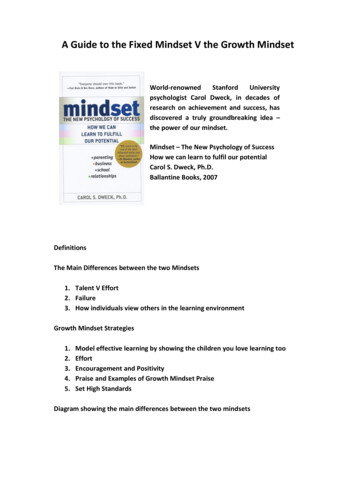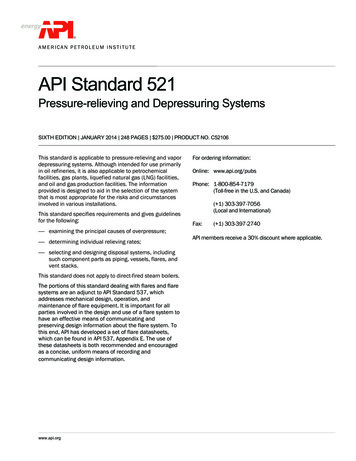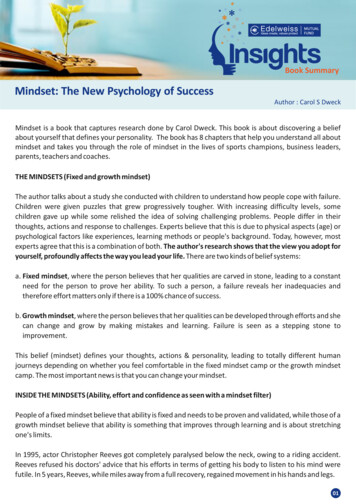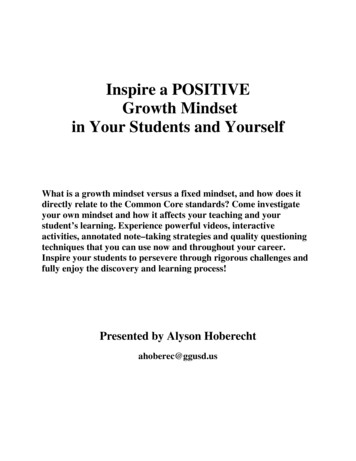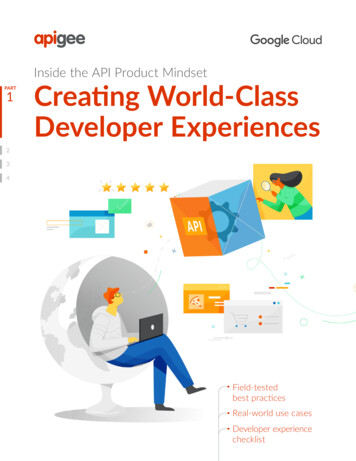
Transcription
Inside the API Product MindsetPART1Creating World-ClassDeveloper Experiences234Field-testedbest practicesReal-world use casesDeveloper experiencechecklist
Table of contentsInside the API product mindset . 03Understanding developers—internal and external—as API customers . 05Field-tested best practices . 07Build an easy-to-use, self-service developer portal to drive adoption . 07Create a community of developers . 08Never stop improving . 09Real-world use cases . 10How AccuWeather reached new audiences with its developer portal . 10Developer experience checklist . 11About Apigee API management . 12
Inside the API product mindsetApplication programming interfaces, or APIs, are the de facto mechanism for connecting applications,data, and systems—but they’re also much more.APIs abstract backend complexity behind a consistent interface, which means they not only allowone kind of software to talk to another, even if neither was designed to do so, but also empowerdevelopers to leverage data, functions and other digital assets both more efficiently and in newand novel ways.Developers have launched new ridesharing services by combining third-party mapping andnavigational APIs with their own first-party data and functionality, for example. Many applicationsrely on third-party APIs, such as those from Twitter or Google, for authentication. When developerswant to add voice commands to an application but lack the time, incentives, resources or expertiseto build their own natural language technologies, they can turn to APIs to get the functionalitythey need.Because they make digital assets easier to reuse and combine, APIs are in the middle of virtuallyevery digital use case, as are the developers who leverage APIs to make those use cases possible.Many enterprises now view developers as one of the most essential actors in their value chains—the people who translate digital assets into digital experiences that move the business needle.As businesses have realized that APIs can be pivotal to their evolution and growth, they haveincreasingly begun to manage APIs like products, supported by full lifecycles, long-term roadmaps,a customer-centric approach, and constant iteration to meet business needs. In our experience onGoogle Cloud’s Apigee team, organizations that treat APIs as products—as opposed to one-offtechnology projects—are more likely to win with developers and realize the potential value of APIsas business accelerators.03
As we explored in The API Product Mindset ebook, typical roles within an API product teaminclude an API Product Manager who owns the pro- cesses and cross-functional coordinationcritical to the API’s success; an API Architect responsible for designing and guiding the creationof APIs; an API Developer who builds APIs from the API Architect’s designs and implementssecurity policies and other protocols; an API Evangelist who serves as the voice of APIconsumers and owns partner and developer outreach; and an API Champion who works closelywith internal ex- ecutive sponsors to communicate the value of the API program to the rest ofthe organization.API PRODUCT MANAGERAPI ARCHITECTAPI DEVELOPERAPI EVANGELISTAPI CHAMPIONThe API product team typically carries several critical responsibilities: Design secure and easy-to-use APIs and bring them to market Deliver a world-class API developer experience Drive ongoing API improvements with monitoring and analytics Maximize the business value of APIs through API monetization, ecosystem participation,developer evangelism, etc.This eBook takes a deeper look at creating world-class developer experiences and sharesbest practices Apigee has observed for engaging developers and deploying a developerportal that fuels those experiences.04
Understanding developers—internal and external—as API customersAPIs may be intended for different users or purposes. Broadly, the three types of API products are: Public: The API is available for anyone to consume, e.g., a branch locator API.Enterprises typically use public APIs to either monetize valuable proprietary services that may beof use to outsiders or to encourage adoption of their services within new developer communitiesthat can help the enterprise reach new digital ecosystems. Private or partner: The API is available to select partners but not to external developers atlarge, e.g., an API to find out the availability of a company’s financial advisers or APIs that arespecially created for partner needs. Internal: The API is available only to certain employees within the enterprise,e.g., an HR database API that provides access to employee information.For many enterprise leaders, it may be tempting to apply different management philosophies todifferent types of APIs and to view developers outside the company as customers while viewingdevelopers inside the company as employees. These types of distinctions can be dangerous.For instance, companies are increasingly mixing their internal-facing APIs with those of publiclyavailable APIs from third parties. By combining APIs in this way, companies can supplement theirproprietary capabilities without having to proportionately invest in research, development, andstaffing. These APIs also help businesses to more efficiently leverage valuable assets without bespokeconsiderations for each project. The end experience that these API combinations facilitate must beseamless to the user, regardless of whether the combinations involve public, partner or privateAPIs and regardless of whether the end user is inside or outside the organization. If some of the APIsare managed as products while others are managed as middleware, this cohesion may be at risk.Retailers, for example, often combine their internal inventory APIs with external payment processingAPIs and external shipping and logistics APIs in order to create seamless mobile e-commerceexperiences. These retailer applications sometimes incorporate external third-party location andnavigation APIs to offer functionality that lets customers pick up a purchase at a nearby storerather than have it shipped to them. Applications might include machine learning APIs to supportvoice interactions or create better recommendation engines.05
The possible combinations are endless—but the point is, to a retailer’s customers, the overallexperience is the product of many interactions from many parties and many APIs, including thoseowned by the specific retailer and those owned by others. For the end user, the distinction betweeninternal and external APIs is not particularly meaningful—they all need to be managed to providegreat experiences for developers so those developers can provide great experiences for users.Similarly, an API used for purely internal purposes may prove itself so useful that it becomesa candidate for externalization. But a business’sawareness of the internal API’s value may be itself largely predicated on the API being managedand monitored like a software product ratherthan a middleware detail. If internal-facing andexternal-facing APIs are approached differently,with the enterprise paying attention to usagepatterns and customer needs only for the latter,the company may never understand which ofits internal services could produce value if madeaccessible outside the company.Finally, even though many businesses invest in great experiences for external developers who payfor monetized APIs or spread an enterprise’s services to new use cases, some of these organizationsgive internal developers a second-rate experience, saddling them with manual approval processes,missing documentation, and other productivity-killing frustrations and potential security risks.It’s counterproductive to recognize the value of well-supported external developers while neglectingto support internal talent.Many large enterprises are accustomed to working in silos, for example, which means, among otherthings, that one team creating APIs in one part of the organization might not be aware of APIsbeing created by other teams throughout the organization. This can lead to work being needlesslyduplicated and to APIs that might be simple for one team to use but confusing and prone tosecurity vulnerabilities for another team’s uses. In these organizations, internal developers are toooften stymied by cross-team confusion and heavy governance models. Without an API team anda unifying product mindset presiding over all APIs, these internal developers may not achieve thestatus of “customer,” the APIs they use may not achieve the status of “product”—and an organization’sproductivity and innovation could suffer as a result.06
Field-tested best practicesBuild an easy-to-use, self-service developer portal to drive adoptionThe faster a developer can go from accessing an API to creating a new experience or service, themore likely they will be to adopt the API. Creating a branded, self-service developer portal—i.e.,an online API storefront—is one of the most powerful ways to provide this access, regardless ofwhether the API customer is an internal or external developer.A successful portal experience often starts with an API directory where developers can beginexploring. APIs should be not only accessible but also supported by documentation, sample codeor SDKs, and even sandbox environments that make it easy for developers to start testing andexperimenting. Beyond simply issuing API keys to developers, the portal may allow customers topurchase API products and packages tailored for different levels of functionality and traffic overhead.Above all, a developer portal should clearly express the value proposition of a company’s APIs andinspire excitement about how developers can use them. Effective portals eliminate barriers thatimpede developer productivity.As Thomas Squeo, senior vice president at telecommunications firm West Corp, recently stated,developer portals are “the primary interaction point where [a developer] can go from awarenessto activation to acquisition for an API and be able to bring it up to a ‘Hello World’ within maybe30 minutes.”SECTION SUMMARYBuild a store for your APIs Enable self-service. Make it easy to get started. Reduce time to “Hello World.” Go beyond access to APIs. Make the value proposition clear. Include documentation,sample code, and testing environments. Reduce complexity and barriers to entry, as withany product sold online. Craft developer experiences that provide the same support and care for both internal andexternal developers.07.
Create a community of developersPeer-to-peer recommendations remain one of the most powerful forces in the software world.A thriving developer community can help an API program grow by creating buzz that encouragesnew developers to enter the community and by enabling feedback loops that help the API providerimprove its program.A developer portal may play a central role in fostering community. By including blogs and forumsin its portal, an enterprise can not only help developers to share best practices around the use ofits APIs but also create dialogs with its API customers. These community efforts are important toensuring that a company’s strategies actually serve user needs. Many businesses make the mistakeof creating strategies from the inside-out, with internal assumptions leading the way, instead offrom the outside-in, with user data and needs guiding development.Additionally, enterprises should invest in establishing a presence where developers already gather—meetups, conferences, online channels, etc. API providers should have a strong presence on socialmedia, both to interact with users and amplify success stories that users share, and should considerdigital marketing tactics such as search advertising.Whether they’re sending representatives to a conference, sponsoring hackathons or posting tosocial media, enterprises should consider marketing tactics that may incentivize participation, fromgiving away swag to recognizing and promoting the work of top API users. Enterprises should alsoaspire to earn the respect of their customers via transparency whenever possible, whether sharingroadmap intentions and timelines or speaking candidly in the event of a breach about what causedthe vulnerability and what can be done to fix it.Many top businesses have created developer evangelist roles to take their community-buildingefforts to the next level. Evangelists can work both inside and outside the enterprise to championadoption of APIs and provide a personal touch to supplement online feedback and marketing efforts.Top API evangelists are generally easy for developers to find on social media and often share theirmessage during not only conference appearances but also webcasts, blog posts, and any otherchannels that offer an opportunity to interact with API users. Effective evangelists can even establishnew business partnerships through their advocacy, giving them a prominent role in growing anenterprise’s digital ecosystem.08
SECTION SUMMARYSpread the word Embrace a variety of channels. Be where the developers are. Considering incentivizing participation via swag or recognition. Task API evangelists with spreading the message. Be honest, transparent, and passionateabout user success.Never stop improvingThe standard for a great developer experience is not static. What satisfies or empowers developerstoday may seem substandard tomorrow as new competing resources emerge and expectationsamong end users continue to evolve. API providers should regularly update their APIs, striving tocontinually close any gaps between what the API offers and what developers need in orderto innovate.An API provider must be able to offer support when developers are stuck. It must be able to maintainthe quality of its services and remediate bottlenecks. To fuel improvements to its API products, theprovider must collect not only hard data by actively monitoring API usage but also qualitativefeedback from developers themselves. Developers are more likely to feel connected to an APIprogram if they feel heard, and they are more likely to promote the APIs with which they feelmost involved.An API provider may also need to rethink the metrics to which it dedicates the most attention.The number of APIs produced, for example, is not a particularly meaningful metric because itprovides little or no insight into how or by whom the APIs are being used. APIs that focus on howdevelopers consume APIs—such as which developers are most active or which applications arelogging the most API calls—open doors to better insights and better API iterations.SECTION SUMMARYIterate. Then iterate again. Always look for ways to make APIs more useful to developers and to make the developerexperience easier and rewarding. Create feedback loops. Provide resources to help developers when they get stuck. Invest in consumption-oriented metrics that provide insight into how and by whomAPIs are being used.09.
Real-world use casesHow AccuWeather reached new audiences with its developer portalAccuWeather, the world's largest weather data company, has for years been sharing itsindustry-leading weather APIs with global OEM partners such as Fitbit, Ford, LG, HTC, and Sony.But it faced a challenge reaching individual developers, small businesses, and the weather-enthusiastcommunity. This was an important audience for AccuWeather, said the company’s senior technicalaccount manager Mark Iannelli.“A single developer always has the potential to be working on the next big thing and become ournext big enterprise partner,” Iannelli explained. “We needed a way to reach them.”“A single developer always has the potential tobe working on the next big thing and becomeour next big enterprise partner, .”Mark Iannelli, Senior TAM at AccuWeatherBy simplifying access to AccuWeather’s unique functionality and APIs via a developer portal, thecompany has enabled a wide range of developers to build applications using the company’s weatherdata. The self-service portal acts an an online store for AccuWeather’s API packages and a hub forits external developer community.This “democratization of APIs” and the improved developer experiences facilitated by the portalalso open the door for new paying customers, Iannelli said. “As developers scale up successfulAPI-based products, they have the possibility to purchase high-volume packages,” he stated.Within 10 months of launch, the portal had attracted more than 24,000 developers, issued over11,000 API keys, and generated hundreds of paid package purchases.But the benefits are even broader, Iannelli said. AccuWeather has also enjoyed not only indirectvalue from a growing developer ecosystem around its services but also exposure in new marketsas developers leverage its APIs in new ways.10
Developer experience checklistHere are some key capabilities that businesses should consider to provide great developerexperiences that will help grow their API programs: Create a custom, branded developer portal to enable API users to access and understandhow to use available APIs and write applications. Portal features should include: Self-service onboarding for new users Role-based access control (RBAC) to maximize security A registry of available APIs, including clear branding to help developers navigate resources Documentation Tutorials and case studies Sample code and SDKs Sandbox environments where developers can begin experimenting Build a developer community through channels, including: Forums, blogs, customer success stories, and newsletters Social media, SEO, and other online marketing Hackathons, meetups, and conferences A developer portal and APIs that are crawlable by search engines Monitor and communicate significant updates or incidents to users, including: Versioning Service status Data breaches Improve API products and support developers with tools and mechanisms, including: Analytics that provide insight into API usage Feedback or bug reporting forums A help center or FAQ.11
About Apigee API managementThe Apigee API management platform delivers full lifecycle API management to help businessesunlock the value of data and securely deliver modern applications. Apigee offers a rich set ofcapabilities to enable enterprises to build customized developer portals, drive ecosystem growththrough API adoption, help deliver world-class developer experiences, and manage APIs as productsto empower developers. Learn more about Apigee’s Integrated Developer Portal.Now that you’ve finished reading,why stop learning?Inside the API Product Mindset - Part 2Maximizing the Business Value of DigitalAssets Through API MonetizationInside the API Product Mindset - Part 3Building and Managing Secure APIsInside the API Product Mindset - Part 4Optimizing API Programs withMonitoring and Analytics12
Share this eBookon socialwith a colleague 2019 Google LLC. All rights reserved.
Creating a branded, self-service developer portal—i.e., an online API storefront—is one of the most powerful ways to provide this access, regardless of whether the API customer is an internal or external developer. A successful portal experience often starts with an API directory where developers can begin exploring.




